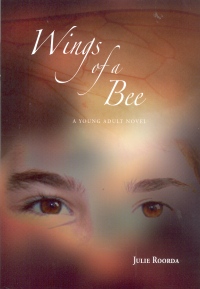| ________________
CM . . .
. Volume XIV Number 9 . . . .December 21, 2007
excerpt:
In Wings of a Bee, which is told in first person from the perspective of Bronwyn, who is six-years-old at the beginning of the story, the reader views the inner workings of a family dealing with the daily reality of cerebral palsy in their middle daughter, Carey. Bronwyn has always come home from school and immediately delved into playing with her sister, working with the constraints of Carey's wheelchair to position paper and a crayon in order to create fridge art that Bronwyn inventively names "Tuna Casserole with Ketchup," "Rodney's Diapers," and "Mr. Spindley's Soul," among others. Often their drawing sessions consist primarily of Carey's producing the art and Bronwyn's telling the story. Bronwyn has an unusual sense of humour and an imagination that scares away more than one neighbourhood child with stories of UFO's, ghosts, and other imaginary dangers. As the years pass and the family adapts to changing circumstances and new difficulties, Bronwyn develops a more complex relationship with her sister in view of the tension between their concern for Carey's health and Bronwyn's new peer relationships. As Bronwyn's mother is increasingly drawn into a battle with the school district to prove and cater to the fact that Carey, despite her physical disability, is of above-average intelligence, Bronwyn deals with conflicting emotions of love and belief in her sister, to jealousy over their mother's attention and her younger sister's superior abilities. While at the beginning of the story, Bronwyn is aware that Carey is different and requires special care, their unique bond and understanding seem to Bronwyn to be an entirely normal family function. The whole family interacts with such a sense of normalcy that Carey is taken for who she is without remonstrations or apologies for her needs. The sense of pride that the whole family elicits for their incredibly creative and intelligent member is shown especially in their response to the student-acted play that Carey has both written and starred in. Their community is also welcoming of Carey, despite the initial reluctance of the school board to accept her in mainstream classrooms and the low-level, unstimulating special-needs classroom environment. When Carey is successfully admitted to Bronwyn's school, Bronwyn begins for the first time to be aware of how Carey's disability could be viewed negatively by the public. However, the Grade 3 class that Carey joins is enamored of her wheelchair and the joy her popularity elicits in Carey, herself. As Carey gets sicker and their mother becomes more distracted with the daily realities of care and quality of life, Bronwyn must learn to deal on her own with those things that scare her, both real and imagined. Clear prose and engaging, original humour make this novel accessible for a variety of readers. The vocabulary and language are uncomplicated but poetic, and the insight into the inner workings and daily struggles of a family dealing with cerebral palsy is invaluable. The title, itself, refers to Bronwyn's belief in and recognition of the miracle that is Carey; her remarkable abilities and distinct personality are evident once you see beyond her external appearance and mannerisms, just as the wings of a bee can't be seen but are known to be present, "...the translucent wings beat so fast they're nearly invisible; to the naked eye, a bumblebee hovering in mid-air is a miracle." Roorda herself grew up with a sibling with cerebral palsy, and the fictionalization of her story, Wings of a Bee, rings true. Highly Recommended. Bryannie Kirk is a student in the Master of Arts in Children's Literature at the University of British Columbia.
To comment
on this title or this review, send mail to cm@umanitoba.ca.
Copyright © the Manitoba Library Association. Reproduction for personal
use is permitted only if this copyright notice is maintained. Any
other reproduction is prohibited without permission.
NEXT REVIEW |
TABLE OF CONTENTS FOR THIS ISSUE
- December 21, 2007.
AUTHORS |
TITLES |
MEDIA REVIEWS |
PROFILES |
BACK ISSUES |
SEARCH |
CMARCHIVE |
HOME |
